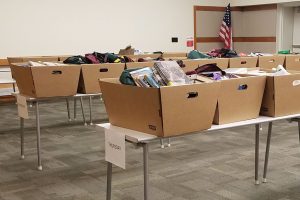
Most years, June marks a shift for students from classroom learning and research to summer vacations, internships, and packed public libraries for reading and learning programs. This year is different, and libraries are rising to the challenge.
A new American Library Association (ALA) survey of US libraries, “Libraries Respond: COVID-19 Survey,” documents a shift in services to support students, faculty, and communities at large during the crisis and phased preparations for the months ahead. While virtually all libraries (99%) report limited access to the physical building, survey respondents shared leaps in the use of digital content, online learning, and virtual programs. More than 3,800 K–12 school, college and university, public, and other libraries from all 50 states responded to the survey May 12–18.
Survey responses show that libraries are involved in community crisis response, cautiously planning for reopening facilities, working to meet the educational needs of students and researchers, reporting increased use of digital services, and anticipating future demands.
“Libraries are places of learning and connection for all ages and backgrounds, so this crisis has challenged us to work creatively to adapt services while our facilities are closed,” said ALA President Wanda Kay Brown. “From bridging the digital divide to addressing learning loss to aiding job seekers and small businesses, we know library services are essential to campus and community recovery and resilience.”
The survey also reported trends on the following:
- COVID-19 crisis response. Of respondents involved in community crisis response, the majority reported new partnerships, distribution of personal protective equipment (PPE), addressing food insecurity, and sharing accurate community information and resources. “Our community has serious food insecurity issues,” reported High Point (N.C.) Public Library, “and we have been involved in addressing that for the past several years. COVID-19 has made the situation even worse. Ordinarily our [farmers] market has kids’ activities, but those are not possible now. We are focusing solely on the food and working hard making sure those who have SNAP [Supplemental Nutrition Assistance Program] benefits are aware of this opportunity.”
- Caution with facility reopening. Virtually all libraries have expanded virtual and phone services during the crisis, continuing a trend of library activities beyond physical walls. The survey finds that most libraries have limited access to their buildings while they work to establish health and safety protocols for staff, social distancing requirements for patrons, and processes for sanitizing materials. Curbside pickup, delivery, and by-appointment services are the most common next steps as national research and state/local guidance evolve. Thirty-seven percent of respondents expect phased reopening in June and July, whereas almost half (47%) are unsure when buildings will begin to reopen to the public.
- Meeting education needs. K–12 school, academic, and public libraries are working overtime to address the needs of remote learners, teachers, faculty, and researchers. Leading activities include providing curbside pickup of items ranging from laptops to reading materials, virtual reference, new summer learning activities, and new “how-to” guides for accessing virtual resources. “We checked out 143 laptops to students needing devices to do work online,” reported Hawkeye Community College Library in Waterloo, Iowa. “This helped some students persist who may not have in this new learning environment.” Information on K–12 school library services is available from the American Association of School Librarians.
- Public demand for library services. Libraries overall report increased use of virtual library cards, digital content, and virtual programming. “We have been amazed by how far away our online storytimes have reached,” reported Mulvane (Kans.) Public Library. “People message us with thanks from different continents!” As libraries reopen their buildings to the public, they anticipate demand for access to physical and special collections, access to computers and the internet, helping students make up for lost ground, supporting faculty and teacher needs, and application support for government services and employment.
As libraries reopen their physical spaces, patrons can anticipate several adjustments, such as restrictions on the number of people inside the facilities, timed visits, additional cleaning procedures, reduced number of public computers to support physical distancing, and use of masks or other PPE. Phased services will vary by community based on local guidance, so patrons should check with their local libraries.
More than half of public library respondents reported they were transitioning summer learning programs from in-person to online. Last summer, for instance, Canton (Mich.) Public Library hosted about 130 programs with more than 100,000 people. This year it is mailing packets to every household in their community with a poster including 62 activities that will have a corresponding blog post on the library’s website with additional resources. The library is planning online programs, as well as take-home kits. Caseyville (Ill.) Public Library District pushed up its summer reading program launch after hearing concerns from school leadership about learning loss.
“A lot has changed in the last three months, but libraries have an unwavering commitment to providing needed resources to all,” said Ramiro S. Salazar, president of the Public Library Association. “Libraries are foundational to digital equity and our nation’s social infrastructure, and I hope city, state, and federal government leaders will continue to invest in and maximize these community assets.”
For more information on the survey and other related news, please visit ALA’s Pandemic Preparedness resource page.


